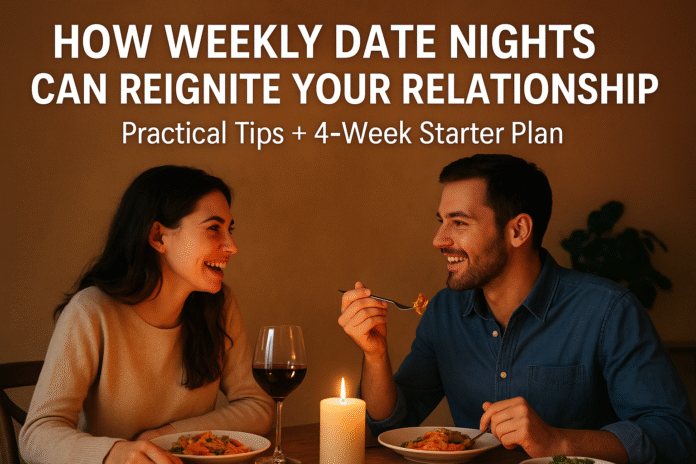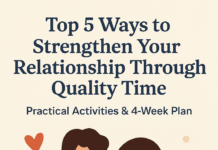If you want to keep the spark alive, smooth out rough patches, and feel closer to your partner on a day-to-day basis, setting aside dedicated “date nights” is one of the most practical, evidence-backed tools you can use. In this article you’ll learn why date nights work, how to plan them (with low-cost options), how often to do them, how to measure whether they’re helping, and a ready-to-run 4-week starter plan. This piece is for couples at any stage — newly dating, long-term partners, parents juggling busy schedules, and people who want a clear, realistic roadmap for prioritizing one-on-one connection.
Key takeaways
- Regular date nights build rituals that increase positive emotion, commitment, and relationship satisfaction.
- Quality beats quantity: even modest, well-planned dates (weekly, biweekly, or monthly) can produce measurable gains when done with intention.
- Variety + novelty = connection: activities that promote “self-expansion” (new, exciting, or shared challenges) deepen closeness faster than repetitive routines.
- You don’t need money or babysitters — at-home and low-cost dates work if they’re planned and protected from distractions.
- Track simple metrics (mood, conversation depth, delight moments) to see whether date nights are improving your relationship over time.
Why date nights matter (what they are and core benefits)
What they are.
A date night is a pre-planned, protected block of time when two partners intentionally focus on each other — no multitasking, minimal tech distractions, and a concrete activity or theme that fosters connection. It can be a night out, a morning walk, a themed dinner at home, or a virtual experience when distance separates you.
Core benefits.
- Emotional reconnection. Repeated, focused one-on-one time rebuilds the sense of partnership and reminds partners why they chose each other.
- Improved relationship satisfaction. Couples who schedule regular dates report higher happiness and, for many, increased sexual satisfaction.
- Increased commitment and positive emotion. When couples create rituals around intentional time together, satisfaction and commitment tend to rise.
- Better communication & reduced conflict drift. Date nights create a safe space for important conversations, planning, and curiosity rather than defensiveness.
- Psychological growth & novelty. Dates that introduce novelty or mutual challenge spark self-expansion, which strengthens attachment.
(These benefits are supported by relationship research showing links between date nights, couple rituals, self-expanding activities, and higher reported relationship satisfaction.)
How date nights function as relationship rituals
What it is and core purpose.
Turning a date night into a ritual means consistently protecting that time and attaching symbolic meaning to it (e.g., “Friday is our time to check in and celebrate”). Ritualized dates differ from routines because they’re performed with shared intention — that meaning amplifies emotional benefits.
Requirements / prerequisites & low-cost alternatives.
- Prerequisites: a mutual agreement, a regular slot (calendar or standing appointment), and an intention statement (what you want the date to accomplish).
- Low-cost alternatives: a 30-minute “no-phones” walk; a candlelit pasta night at home; a shared playlist and slow dance in the living room.
Step-by-step implementation (beginner-friendly).
- Talk for 10 minutes: Agree on an initial cadence (weekly/biweekly/monthly) and how long dates will last. Put it on both calendars.
- Pick the first date: Choose something simple and doable this week.
- Set boundaries: Phones on DND, no work talk, or agreed topics to avoid.
- Debrief for 5 minutes: After the date, share one highlight and one small improvement for next time.
Beginner modifications and progressions.
- Simplify: Start with 30-minute post-work “couch dates” before building to longer evenings out.
- Scale up: After 4–6 successful short dates, plan a half-day date or a weekend mini-getaway.
Recommended frequency/duration/metrics.
- Frequency: Weekly is common; biweekly or monthly works well for many couples. The important metric is consistency.
- Duration: 1–3 hours for an evening date; 20–45 minutes for a mini daily ritual.
- KPIs to track: mood before/after date (scale 1–5), perceived closeness (1–5), number of uninterrupted conversations longer than 10 minutes.
Safety, caveats, and common mistakes.
- Mistake: Treating date night as a chore. If it becomes an obligation, pause and adjust frequency or content.
- Caveat: Rituals only help when both partners see them as meaningful — mutual buy-in matters.
- Safety: If one partner is experiencing mental health issues, date nights may need to be adapted (shorter, less demanding). Encourage professional support when needed.
Mini-plan (2–3 steps).
- Block one evening per fortnight on both calendars.
- Pick a simple at-home activity (cook together) and set phones to DND.
- After dinner, share three things you appreciated about each other that week.
Types of date nights and how to choose (at-home, out, budget, travel, virtual)
What it is and core benefits.
There’s no single “right” date format. Different types serve different goals: at-home dates are accessible and intimate; nights out stimulate novelty; active dates improve mood and build teamwork; virtual dates keep connection alive over distance.
Requirements/prerequisites & low-cost alternatives.
- Out on the town: Budget for food/transport/tickets. Low-cost alternative: a picnic in a local park.
- At-home: A private space, snacks, and a simple activity. Low-cost: cable/streaming service you already have, candle, playlist.
- Active/outdoor: Comfortable shoes, weather-appropriate clothing. Low-cost: neighborhood walk, community sports.
- Virtual/long-distance: Stable internet, shared app or streaming choice. Low-cost: watch a synced movie or play an online game.
Step-by-step instructions (pick one type).
- At-home themed dinner:
- Decide the theme (Italian night, street tacos, tapas).
- Shop for ingredients together or split the prep.
- Play a themed playlist, eat without devices, and ask each other three curiosity questions.
Beginner modifications and progressions.
- Modify: Make the first at-home date 45 minutes.
- Progress: Move from cooking a simple meal to hosting a themed cooking challenge or learning a new cuisine together.
Recommended frequency/duration/metrics.
- Mix types across months: e.g., 1 out event + 2 at-home dates per month.
- Duration: Out dates often 2–4 hours; at-home 45–90 minutes.
- Metrics: novelty score (1–5), laughter incidents (number), post-date closeness (1–5).
Safety, caveats, and common mistakes.
- Mistake: Choosing activities that only one partner enjoys. Rotate planning and negotiate.
- Caveat: High-intensity dates (rock climbing, long hikes) need basic fitness and safety prep.
Mini-plan (2–3 steps).
- Pick a monthly rotation: Out / At-home / Active.
- Tonight: at-home wine & tapas for 60 minutes.
- When planning the next out date, take turns choosing the activity.
Planning date nights that produce closeness (self-expansion and novelty)
What it is and core benefits.
Date nights that involve novelty or learning together stimulate “self-expansion” — the psychological process where partners grow by trying new things together. This reliably boosts closeness faster than repeating the same dinner-and-movie routine.
Requirements/prerequisites & low-cost alternatives.
- Prerequisites: Willingness to try something unfamiliar and emotional safety to be awkward together.
- Low-cost ideas: Try a new board game, enroll in a free local class, or do a themed DIY project.
Step-by-step: create a “self-expansion” date.
- Brainstorm a list of 6 things neither of you has tried but would be curious about.
- Pick one that feels manageable and book it or clear time.
- Go together with an explicit intention: “This date is about trying, laughing at mistakes, and sharing what we learned.”
Beginner modifications and progressions.
- Simplify: Choose a small novel activity—try a new dessert recipe.
- Scale: Move from small experiments to weekend escapes with new activities (kayaking, pottery).
Recommended frequency/duration/metrics.
- Frequency: Aim for at least one novel/self-expanding date per month.
- Duration: 1.5–4 hours depending on activity.
- Metrics: novelty score (1–5), learning moments (count), closeness change pre/post date.
Safety, caveats, and common mistakes.
- Mistake: Picking an activity that triggers stress (e.g., extreme sports with one anxious partner).
- Caveat: Novelty helps, but must be balanced with activities that feel safe and enjoyable for both.
Mini-plan (2–3 steps).
- Compile a “curiosity jar” of 12 new things to try.
- Pull one at random for the next date.
- After the date, each list one new thing you enjoyed or would change.
Practical logistics: scheduling, budgeting, childcare, and tech boundaries
What it is and core benefits.
Good logistics reduce friction so date nights actually happen. This means proactive scheduling, cost planning, childcare arrangements if needed, and clear tech rules.
Requirements/prerequisites & low-cost alternatives.
- Prerequisites: Shared calendar access (digital or printed), budget agreement.
- Low-cost solutions: Rotate babysitting with friends/family, swap nights with other parents, use in-home micro-dates after kids are asleep.
Step-by-step logistics plan.
- Block it: Put recurring date nights on both calendars for 3 months.
- Budget it: Create a simple “date fund” — even $10–20 per month covers many at-home extras.
- Childcare: Arrange a standing babysitter or swap with another family. If not possible, schedule in-house dates after the kids go to sleep.
Beginner modifications and progressions.
- Modify: Start with monthly dates to test feasibility.
- Progress: If monthly works, move to biweekly or weekly.
Recommended frequency/duration/metrics.
- Frequency: Choose what’s realistic — the best cadence is the one you keep.
- Budget metric: monthly expenditure vs. satisfaction change. If cost is high and satisfaction low, iterate.
Safety, caveats, and common mistakes.
- Mistake: Overbooking without financial or childcare capacity.
- Caveat: If finances are tight, creative no-cost options (walks, library events, home karaoke) maintain momentum.
Mini-plan (2–3 steps).
- Create a recurring calendar entry for the next 6 dates.
- Set a monthly “date budget” of any affordable amount and track spending.
- Confirm childcare arrangements one week before each out date.
Conversation recipes for date nights (structured communication that deepens intimacy)
What it is and core benefits.
A “conversation recipe” is a short, repeatable structure for talking that reduces awkwardness and increases emotional depth. The benefit: more meaningful exchanges without the stress of “what do we talk about?”
Requirements/prerequisites & low-cost alternatives.
- Prerequisites: Willingness to listen, no phones, and agreed time limits.
- Low-cost: Print or memorize a couple of question prompts or use free card games designed for couples.
Step-by-step conversation recipe (Beginner).
- Warm-up (5 minutes): Share one highlight and one lowlight from the week.
- Curiosity round (10–15 minutes): Ask one open question each (see prompts below).
- Future tiny-step (5 minutes): Decide one small thing you’ll do together this week.
Beginner modifications and progressions.
- Simplify: Use a single question per date.
- Scale: Introduce a deeper theme every third date (values, dreams, boundaries).
Recommended frequency/duration/metrics.
- Use every date. Even a 20-minute conversation recipe increases perceived closeness.
- Metric: count the number of meaningful, uninterrupted exchanges per date.
Safety, caveats, and common mistakes.
- Mistake: Using date night to re-argue old fights. If a topic turns heated, pause and schedule discussion for another time.
- Caveat: For serious relational concerns, couples therapy may be necessary.
Mini-plan (2–3 steps).
- Print three conversation prompts and place them under a candle.
- During dessert, pick one card and follow the recipe above.
- Close with one thing to look forward to before the next date.
(Sample prompts: “What small future habit would make you feel more loved?” “Tell me about a dream you had as a teenager.” “When did you feel most proud of me this month?”)
Measuring progress: how to know if date nights are working
What it is and core benefits.
You can treat date nights like a small experiment: track a few simple metrics and reflect after 4–8 weeks to see whether they’re helping.
Requirements/prerequisites & low-cost alternatives.
- Prerequisites: A willingness to check in honestly, a shared metric tracker (notes app or printed sheet).
- Low-cost: Use a shared Google Doc or a note on the fridge.
Step-by-step measurement plan.
- Choose 3 simple metrics: mood change, closeness rating, and frequency kept.
- After each date, both partners rate mood before/after and jot one sentence about what felt good.
- Review entries at the end of each month and discuss one tweak.
Beginner modifications and progressions.
- Simplify: Just track mood before/after for the first month.
- Scale: Add qualitative notes about conversation topics and surprises.
Recommended frequency/duration/metrics.
- Review monthly and adjust cadence/activities.
- Metrics: average closeness bump (scale 1–5), number of dates completed vs planned.
Safety, caveats, and common mistakes.
- Mistake: Over-analyzing. If ratings dip once, don’t panic — trends matter more than single data points.
- Caveat: Measurement is a tool for better conversations, not a scoreboard.
Mini-plan (2–3 steps).
- Start a “Date Night log” in a shared note.
- After each date, both add a one-line note: mood before/after (1–5) + one highlight.
- End the month by reading the log together and planning next month.
Troubleshooting and common pitfalls (why date nights fail and what to do)
What it is and core benefits.
Troubleshooting identifies typical reasons date nights stop working and offers quick fixes so you can consistently protect couple time.
Common problems and fixes.
- Problem: Dates feel like chores. Fix: Reduce frequency; make dates fun and low-pressure.
- Problem: One partner resents planning. Fix: Alternate planning or use a “date night jar” where each picks one slip.
- Problem: Kids or schedules block time. Fix: Stand-up dates (30 minutes after kids sleep), micro-dates, or swap babysitting with friends.
- Problem: Conversations spiral into arguments. Fix: Use a “pause” word and postpone heavy topics to therapy or a scheduled talk.
Step-by-step recovery plan (if you’ve missed many dates).
- Have an honest 10-minute conversation to diagnose the barrier.
- Pick one tiny commitment (e.g., 30-minute at-home date this week).
- Celebrate the small win and schedule the next two dates.
Beginner modifications and progressions.
- Modify: If weekly is failing, try biweekly with a stronger emotional focus.
- Progress: Once rhythm returns, experiment with different date types.
Recommended frequency/duration/metrics.
- Reassess after three attempts to restart; if momentum hasn’t improved, consider couple therapy or a joint planning retreat.
Safety, caveats, and common mistakes.
- Mistake: Using date nights as a bandaid for deeper issues (chronic resentment, infidelity). If core trust is broken, prioritize professional support.
Mini-plan (2–3 steps).
- Each partner lists perceived barriers (five minutes, no judgement).
- Choose one barrier to solve this week.
- Plan a no-pressure mini-date to celebrate the attempt.
How to keep variety without losing ritual: the balance between novelty and reliability
What it is and core benefits.
Too much routine makes dates stale; too much novelty costs energy and money. The trick: anchor a reliable ritual around a rotating set of activities.
Requirements/prerequisites & low-cost alternatives.
- Prerequisite: An agreed structure (e.g., “first Friday = Out, second Friday = At-home”).
- Low-cost: Use themes rather than expensive outings (theme nights at home, museum on free entry day).
Step-by-step rotation plan.
- Create three buckets: Comfort (reliable), Novelty (new), and Growth (learn together).
- Schedule a rotation that mixes all three across a month.
- Keep one spontaneous slot for surprise treats.
Beginner modifications and progressions.
- Modify: Start with Comfort + Novelty each month.
- Scale: Add a Growth date (class, workshop) every quarter.
Recommended frequency/duration/metrics.
- Maintain at least one Comfort date per month for stability.
- Track perceived freshness (1–5) to detect boredom early.
Safety, caveats, and common mistakes.
- Mistake: Never deviating from comfort dates; boredom creeps in.
- Caveat: Don’t force novelty if both partners are exhausted — adapt.
Mini-plan (2–3 steps).
- Set a monthly calendar: Comfort / Novelty / Growth.
- This month: Comfort = movie night, Novelty = food truck crawl, Growth = pottery class (or online tutorial).
A simple 4-week starter plan (roadmap)
This realistic plan builds a habit and mixes at-home, novelty, and conversation practice.
Week 1 — Kickoff (Short, low-friction)
- Type: At-home comfort date (60 minutes).
- Steps: Cook a simple meal together. Phones on DND. Use the conversation recipe (warm-up, curiosity question, plan one small thing). Log mood before/after.
Week 2 — Novelty (Try something new)
- Type: Novelty date (90–120 minutes).
- Steps: Try a new experience (local walk in a new neighborhood, new dessert recipe, or a free local event). End with one “learned” statement each and log results.
Week 3 — Active/Playful (Movement or collaborative task)
- Type: Active date (60–90 minutes).
- Steps: Take a dance class, play mini-golf, or do a home project together. Focus on teamwork and fun. Debrief with one highlight and one improvement.
Week 4 — Deep-connect (Longer conversation + ritual)
- Type: Ritualize it (90+ minutes).
- Steps: Create a ritual—light a candle, play a particular playlist, and discuss future goals for the relationship. Review the Date Night log and pick a cadence for month two.
Metrics to track across four weeks: Dates completed vs planned; average closeness bump (1–5); number of laughter/joy moments noted; one insight gained.
Quick-start checklist & warm-up
Quick-start checklist
- Block a date on both calendars for the next 4 weeks.
- Decide on frequency (weekly/biweekly/monthly).
- Agree on one tech boundary (phones away, Do Not Disturb).
- Choose your first date (simple, achievable).
- Set a budget or low-cost plan.
- Prepare one conversation prompt.
5-minute warm-up ritual
- Take three synchronized deep breaths together.
- Say one thing you’re grateful for about your partner.
- Put phones away and start the activity.
Safety, when to slow down, and when to seek help
Date nights are a relationship tool, not a cure for major problems. If either partner is dealing with severe depression, substance issues, ongoing mistrust, or a history of abuse, date nights should be adapted and professional help sought. Use date nights to foster safety and shared meaning, but don’t use them to avoid or paper over serious issues.
FAQs (10)
1. How often should couples have a date night?
There’s no single rule. Many experts recommend aiming for a consistent cadence (weekly, biweekly, or monthly). Studies indicate benefits even at once or twice a month; the key is sustained, intentional time together.
2. Do date nights really make a difference long-term?
Yes—couples who regularly make space for one-on-one time tend to report higher relationship satisfaction and commitment. Ritualized, meaningful dates amplify this effect.
3. What if we can’t afford to go out?
At-home and low-cost dates (cooking, themed nights, walks) produce many of the same benefits when planned and protected from distractions.
4. One partner isn’t into planning — what should we do?
Rotate who plans, use a “date jar” where each partner writes ideas, or agree to alternate responsibility to share emotional labor.
5. My partner prefers quiet nights and I want adventurous dates — how do we balance?
Compromise by alternating or combining: a low-energy at-home date one week and a short novelty date the next. Discuss energy levels in advance.
6. How do we avoid arguing during date night?
Agree on boundaries up front (no problem solving, no heavy topics) and use a pause word if conversation turns heated. If conflicts persist, schedule a separate time for discussion or seek therapy.
7. Are date nights helpful with kids?
Yes — even short, protected moments after kids sleep or a monthly out-of-house date can be valuable. Consider babysitter swaps or family support networks.
8. Should we measure progress?
Simple tracking (mood before/after, closeness rating) helps you evaluate whether your dates are improving connection. Keep it light and use it as a guide, not a scorecard.
9. What are easy conversation starters for date night?
Try open prompts like: “What surprised you this week?” “Tell me a dream you had as a child.” “What’s one small thing I could do that would make you feel more supported?”
10. When should we consider couples therapy instead of more dates?
If you experience chronic distrust, repeated patterns of harm, infidelity, or persistent unresolved conflict, seek professional help. Date nights are supportive but not a substitute for therapy when deeper issues exist.
Conclusion
Date nights are a simple, flexible practice that — when done with intention and consistency — can renew affection, sharpen communication, and strengthen commitment. They don’t require perfection, expensive outings, or lengthy time commitments. What matters is protecting the time, keeping curiosity alive, and choosing activities that build shared meaning. Start small, measure lightly, and let your date nights become one of the rituals that remind you why you chose each other.
Call to action: Pick a date, block it on your calendar, and try a 60-minute at-home date this week — protect it, be curious, and see what changes in four weeks.
References
- The Power of Date Nights. Institute for Family Studies (blog). Published online (accessed 2024). https://ifstudies.org/blog/the-power-of-date-nights
- Planning date nights that promote closeness: The roles of relationship goals and self-expansion. Journal article (open access). Published 2021. https://pmc.ncbi.nlm.nih.gov/articles/PMC8170361/
- Rituals and Nuptials: The Emotional and Relational Consequences of Relationship Rituals. Harvard Business School Working Paper (PDF) — Garcia-Rada, Sezer & Norton. Published 2019. https://www.hbs.edu/ris/download.aspx
- Time Spent Together in Intimate Relationships: Implications for Relationship Functioning. Open-access article (PMC). Published 2021. https://pmc.ncbi.nlm.nih.gov/articles/PMC8320759/
- Date nights linked to stronger marriages — research summary. Williamsburg Therapy Group (article summarizing research findings). Published 2023. https://williamsburgtherapygroup.com/blog/research-shows-that-date-nights-are-linked-to-stronger-marriages-more-sexual-satisfaction
- This Is How Often Married Couples Should Plan Date Nights. Brides (advice piece, expert quotes). Published 2022. https://www.brides.com/married-couples-date-night-frequency-6823194




































